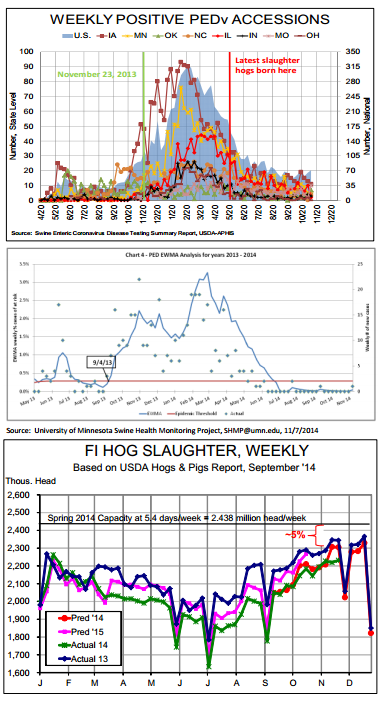



CME: What is Happening with PEDv?
US - The over-riding question for hog markets remains “What is happening with PEDv?“ Writes Steve Meyer and Len Steiner.We would add to that “And what can we glean from the information available?” The second question has probably been more germane to markets from the beginning and we fear that a good answer is still hard to come by but let’s take stock of where we stand and what we think we know at this point.
PEDv case accessions have risen slightly as temperatures have cooled but they are not growing at anywhere near the pace they did last year.
The last data in the now?familiar PEDv case accession chart at right represents the week ended 9 November.
Their were 71 total positive accessions that week. That compares with 90 one year ago.
Notably, 37 of the 71 cases were in Oklahoma, Texas, Kansas and Missouri and not the colder weather states that would have been suspected at this time.
It is important to remember that we know little about these case accessions other than that a sample tested positive for PEDv.
Many of the samples being submitted are from monitoring efforts of previously?infected farms.
Those will not represent new cases and may not represent situations in which death losses are significant.
That fact differs markedly from last fall and winter when the disease was new.
The number of cases in sow herds remains extremely low. The chart below from the University of Minnesota indicates that only six sow herds among the 738 owned by the 19 cooperating production companies have broken with PEDv since 1 June.
It appears that there were about 140 such herds last year.
These 19 companies have 2.1 million sows, about 40 per cent of the total US herd. These lower sow herd accessions suggest smaller-than-expected year/year declines in pig output late this year and through the first quarter of 2015.
Hog slaughter has been very close to the levels predicted by the September Hogs and Pigs report. Until the past two weeks, total slaughter since 1 September was less than one per cent below the levels we had forecast based on the USDA numbers without any specific adjustments for PEDv impacts.
Slaughter the past two weeks has been 5.4 per cent and 4.8 per cent short of 2013.
It is notable that the predictions for those weeks are based on the 50-119 pound inventory in the September report that showed much lower year-on-year reductions (1.7 per cent) than did the 120189 pound category (3.5 per cent).
It looks as though pig output did not get better by that much that quickly.
Anecdotal evidence suggests that conditions are better even on farms that are seeing challenges.
Our talks with a number of knowledgeable veterinarians indicate that producers are still having problems with litters from gilts and second?litter sows when the virus is present but that older sows that have been exposed are apparently passing immunities along to their litters.
We heard no definitive statements about the role that vaccines are playing but most believe they are helping by boosting immunity in these previously-exposed females.









